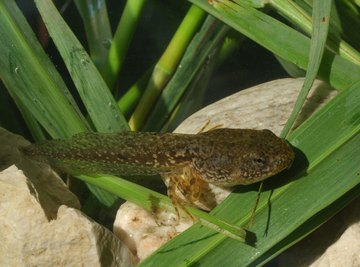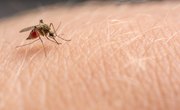
A tadpole, which is a frog or toad in its aquatic larval stage, lives in many different water bodies. In this early stage, it has a short, oval body with a small mouth, a broad tail and no external gills. For most frog and toad species, the tadpole stage lasts for one to three months, and then undergoes metamorphosis to become a young froglet or toadlet. During metamorphosis, the forelimbs, hind limbs and lungs develop, the intestine shortens, the gills disappear and the tail disappears.
Finding Tadpoles
Tadpoles live in water (although they can survive out of water if they stay moist). You can find tadpoles in ponds, small lakes, rivers and creeks. Tadpoles also live in public parks, refuges and conservation areas. Tadpoles spend most of their time eating algae and swimming near the water's surface.
Catching Tadpoles
The easiest way to catch tadpoles is with a small mesh tadpole net. However, every state has different laws on catching tadpoles. In some states, such as California, kids can catch tadpoles without a license, but over-16s need a fishing license (the same applies for catching fish, amphibians, mollusks, crustaceans, invertebrates or reptiles). Some states also have restrictions on what species of tadpoles you can catch. For example, in California you need a special permit to collect endangered or threatened species, or species of special concern. This means it's important to know how to ID tadpoles so you don't accidentally collect an endangered or threatened species. Your local department of natural resources or nature center can help you identify tadpole species.
Contact your state department of natural resources to find out what laws apply to catching tadpoles, and always ask permission before catching tadpoles on private property.
Raising Tadpoles
Make sure the tadpoles fit comfortably in your tadpole tank or aquarium. A good rule of thumb is less than 1 inch of tadpole per gallon of water, to prevent overcrowding. Fill your tank with pond water or creek water from an unpolluted source, or tap water treated with a chemical dechlorinator, which you can get from pet shops. Feed your tadpoles with algae from an unpolluted water source, or give them fish flakes with a high concentration of plant ingredients.
Ensure your tank has a secure lid, and a "land" area against one edge of the tank for the developing tadpoles to crawl out of the water as they move from breathing with gills to lungs.
In some states it’s illegal to release frogs back into the wild after they have been in captivity. This rule protects native species and restricts invasive species, such as bullfrogs. So if you want to collect and rear tadpoles to frogs, you must keep them for life or give them away.
References
About the Author
Claire is a writer and editor with 18 years' experience. She writes about science and health for a range of digital publications, including Reader's Digest, HealthCentral, Vice and Zocdoc.
